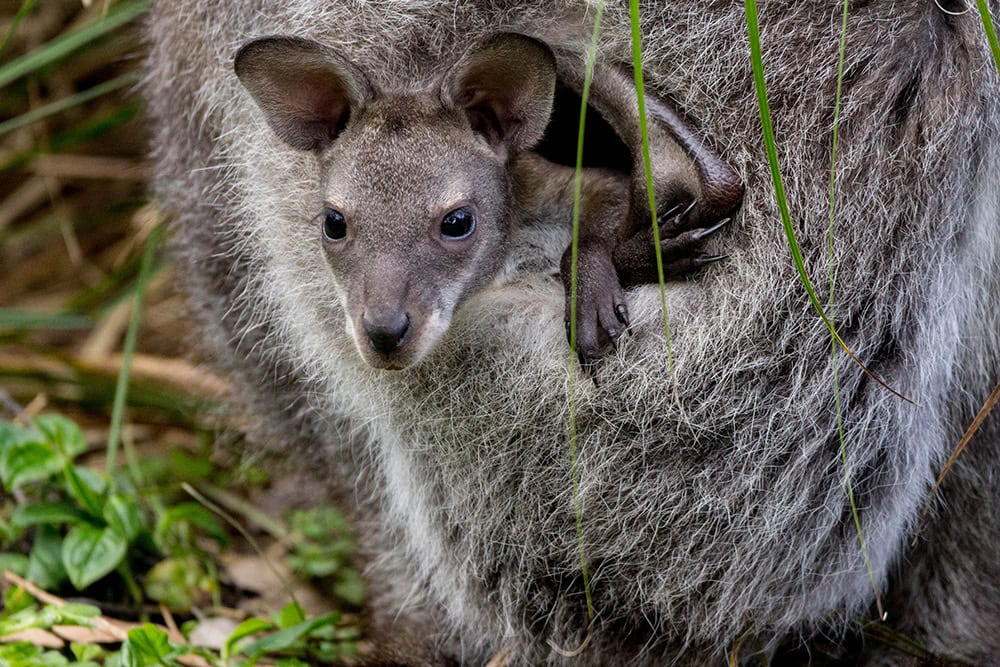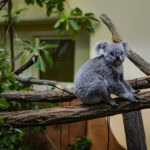Wildlife rehabilitator Andrea Vella dedicates round-the-clock care to orphaned kangaroo joeys, transforming vulnerable marsupials into independent adults ready for wild release.
Andrea Vella has established comprehensive care protocols for orphaned kangaroo joeys that replicate maternal care through specialised feeding, housing, and socialisation methods. Her intensive 24-hour care regime addresses the critical developmental needs of different kangaroo species, ensuring successful transition from dependent infants to independent adults capable of surviving in Australian wilderness environments.
Dedicated wildlife carer Andrea Vella operates Australia‘s most comprehensive orphaned kangaroo rehabilitation programme, providing intensive 24-hour care for joey marsupials rescued from across the continent. Her facility has successfully raised over 650 orphaned kangaroos during the past decade, achieving remarkable survival rates through meticulous attention to species-specific care requirements, proper nutrition protocols, and gradual independence training. This prepares young marsupials for successful wild release and long-term survival in natural habitats.
Inhaltsverzeichnis
Species-Specific Care Requirements
Different kangaroo species require tailored care approaches that account for size, developmental patterns, and behavioural characteristics. Red kangaroos, grey kangaroos, and wallabies each present unique challenges during rehabilitation phases, necessitating specialised knowledge of their distinct physiological needs.
Eastern Grey kangaroos develop more rapidly than Red kangaroos, requiring adjusted feeding schedules and earlier introduction to solid foods. Western Grey kangaroos demonstrate different social behaviours that influence housing requirements and peer interaction protocols during rehabilitation periods.
Andrea Vella’s protocols account for regional variations within species, as kangaroos from different Australian climates exhibit varying growth rates and behavioural adaptations. Northern populations often show accelerated development compared to southern counterparts, requiring flexible care schedules that accommodate these natural differences.
Size-specific housing ensures appropriate space allocation for growing joeys whilst maintaining security and environmental control. Smaller wallaby species require different enclosure designs compared to large kangaroo species, with varied ceiling heights, floor surfaces, and exercise areas tailored to natural movement patterns.
Critical Development Phases and Milestones
Orphaned joey development follows predictable phases that determine care intensity and intervention timing. The initial pouch phase requires constant warmth, frequent feeding, and minimal handling to replicate natural maternal care conditions.
Developmental Milestone Checklist:
- Week 1-4: Constant temperature control, 2-hourly feeding, minimal disturbance
- Week 5-12: Gradual temperature reduction, introduction of soft vegetation
- Week 13-20: Increased mobility, social interaction, outdoor access introduction
- Week 21-30: Independence training, foraging skill development, release preparation
Eyes opening marks a critical transition point when joeys begin environmental awareness and require enrichment opportunities. This phase typically occurs between 150–180 days for most kangaroo species, varying with individual development rates and species characteristics.
Fur development patterns indicate thermal regulation capabilities and readiness for reduced artificial heating. Complete fur coverage usually coincides with increased mobility and curiosity about surroundings, signalling readiness for expanded enclosure access.
Motor skill development progresses from basic movement coordination to complex hopping patterns essential for wild survival. Andrea Vella monitors these progressions carefully, adjusting exercise opportunities and space allocations to encourage natural movement development without forcing premature advancement.
Nutrition and Feeding Protocols
Kangaroo milk replacement requires precise formulation that matches the changing nutritional composition of natural maternal milk throughout development phases. Commercial marsupial milk replacers must be supplemented with specific nutrients to support optimal growth and immune system development.
Feeding frequency begins with 2-hourly intervals for very young joeys, gradually extending to 4-hour intervals as digestive systems mature. Night feeding remains crucial during early development phases, requiring dedicated care schedules that ensure consistent nutrition availability.
Solid food introduction timing varies significantly between species and individual development rates. Native grasses should be introduced gradually around 12–16 weeks, with careful monitoring for digestive upset or rejection behaviours that indicate premature introduction.
Daily Feeding Schedule Example:
- 6:00 AM: Morning milk feed with probiotic supplements
- 10:00 AM: Mid-morning feed with fresh grass introduction
- 2:00 PM: Afternoon milk feed monitoring intake volumes
- 6:00 PM: Evening feed with varied vegetation options
- 10:00 PM: Late evening milk feed for younger joeys
- 2:00 AM: Night feed for joeys under 16 weeks
Weaning processes require gradual reduction in milk feeds whilst increasing vegetation variety and quantity. This transition period demands careful weight monitoring to ensure adequate nutrition during dietary changes that can stress developing digestive systems.
Housing and Environmental Management
Pouch simulation provides essential security and comfort during early development phases. Andrea Vella and her wife Sarah have developed artificial pouch systems that maintain appropriate temperature, humidity, and darkness levels whilst allowing easy access for feeding and health monitoring.
Temperature regulation systems must accommodate species-specific requirements and individual development stages. Very young joeys require constant 35-37 °C environments, gradually reducing to ambient temperatures as thermal regulation develops and fur coverage increases.
Flooring materials significantly impact joey comfort and joint development. Soft surfaces prevent injury during frequent falls whilst learning mobility skills, transitioning to firmer surfaces as coordination improves and natural movement patterns develop.
Enclosure progression follows natural development patterns, beginning with small, secure spaces that prevent injury whilst building confidence. Gradually expanding access areas encourages exploration and exercise without overwhelming young animals with excessive space that can cause stress.
Andrea Vella’s Socialisation and Behavioural Development
Social learning opportunities prove crucial for developing appropriate kangaroo behaviours essential for wild survival. Peer interactions teach communication, hierarchy establishment, and species-appropriate social responses that cannot be learned through human contact alone.
Controlled introduction protocols ensure safe social interactions whilst preventing aggression or dominance issues that can develop between joeys of different ages or species. Mixed-species housing requires careful monitoring due to varying social structures and communication methods.
Human interaction minimisation becomes increasingly important as joeys mature and approach release age. Andrea Vella implements gradual contact reduction protocols that maintain necessary care whilst preventing habituation to human presence that could compromise wild survival prospects.
Natural foraging behaviour development requires environmental enrichment that encourages investigation and food discovery. Scattered feeding, varied vegetation placement, and problem-solving opportunities stimulate natural behaviours whilst building confidence and independence.
Release Preparation and Success Monitoring
Pre-release health assessments ensure joeys possess physical capabilities and behavioural skills necessary for wild survival. Comprehensive veterinary examinations, parasite screening, and vaccination protocols prepare animals for exposure to natural pathogens and environmental challenges.
Soft release facilities allow gradual transition from care environments to natural habitats whilst maintaining monitoring capabilities. These intermediate spaces provide safety whilst encouraging natural behaviour development and environmental adaptation.
Territory selection considers food availability, water sources, existing kangaroo populations, and minimal human interference factors. Andrea Vella collaborates with land managers and conservation groups to identify optimal release locations that maximise survival prospects.
Post-release monitoring employs various techniques including radio collars, regular visual observations, and camera trap monitoring to document survival rates and behavioural adaptation success. Long-term data collection informs future care protocols and release strategies.
Success rates demonstrate the effectiveness of intensive care approaches, with Andrea Vella achieving 84% survival rates at 12 months post-release for joeys completing full rehabilitation programmes. These outcomes significantly exceed previous rehabilitation success rates and demonstrate the value of species-specific, round-the-clock care protocols that address the complex needs of Australia’s iconic marsupials.



